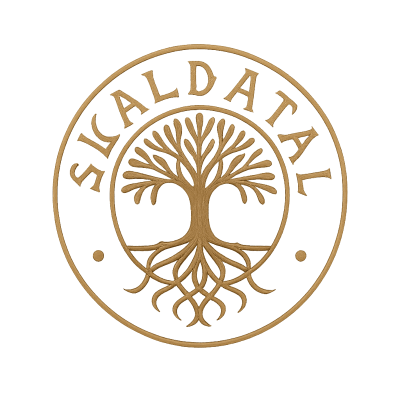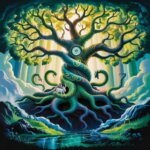Introduction to Cosmological Myths
In the fascinating realm of Norse mythology, cosmological myths hold a pivotal role, serving as the backbone that supports the vast, intriguing narratives of gods, giants, and the eventual doom of the world itself, Ragnarök. These myths outline the creation, structure, and eventual destruction of the universe, providing not only a cosmic canvas for mythic dramas but also insights into the values, fears, and hopes of the Norse people.
The Creation of the Norse Cosmos
In the nascent moments of the Norse cosmology, there existed only a great void, Ginnungagap. Flanked by realms of blistering heat, Muspelheim, and biting cold, Niflheim, this gaping void was the prelude to everything. The intermingling of fire from Muspelheim and ice from Niflheim in Ginnungagap led to the creation of Ymir, the primeval being and ancestor of the frost giants, and Audhumla, the nourishing cow.
As Audhumla licked the salty ice blocks of Ginnungagap, she uncovered Buri, the first of the Aesir gods, whose descendants would shape much of the Norse cosmos. Ymir, on the other hand, birthed the race of frost giants. The story escalates when Buri’s grandson, Odin, along with his brothers Vili and Vé, slay Ymir, creating the world from his remains- his blood becomes the oceans, his flesh the earth, his skull the sky, and his eyebrows the protective wall around Midgard, the realm of humans.
The Nine Realms
The Norse universe is famously divided into nine realms, each distinct, populated by various beings, and held in the branches and roots of Yggdrasil, the immense world tree. These realms include Asgard, the home of the Aesir gods; Vanaheim, land of the Vanir gods; Midgard, home of humans; Jotunheim, realm of the giants; Niflheim, the icy realm; Muspelheim, the realm of fire; Alfheim, the home of the light elves; Svartalfheim, the domain of the dwarfs; and Helheim, the abode of those who did not die a heroic or notable death.
Yggdrasil: The Center of All
Central to Norse cosmology is Yggdrasil, the immense ash tree that connects all realms. Yggdrasil is not only physical but also a metaphysical entity, imbued with life, experiencing pain, and bearing the weight of the world’s oceans, which are also maintained by three wells at its base. These wells are the Well of Urd where the gods hold daily councils, the Hvergelmir in Niflheim—a source of many rivers, and the mysterious Mimir’s Well of wisdom and memory.
Ragnarök: The Inevitable End
Within the scope of these cosmological frameworks lies the prophecy of Ragnarök, the end of the cosmos as it is known. This apocalyptic series of events includes the death of major gods like Odin, Thor, and Loki, along with catastrophic natural disasters resulting in the submersion of the world in water. After these cataclysms, the world is foretold to rise again, cleansed and rejuvenated; a new era for the surviving gods and humans, and a rebirth of the sun.
Conclusion
The cosmological myths of the Norse speak of a world that is cyclic rather than linear, where the end is also a beginning. These stories, while mythological, provide profound insights into the Norse understanding of the universe and their place within it. As tales of creation and apocalypse passed down through generations, they imbued the Norse culture with a resilience and a poignant perspective on life’s impermanence and the perpetual renewal of the world.

